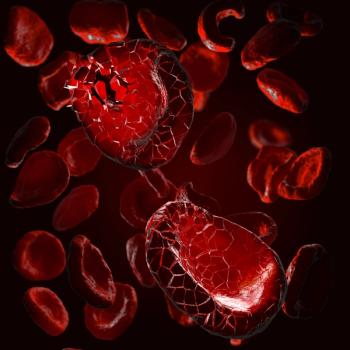
Vosaroxin May Benefit Older Patients With Relapsed, Refractory AML
Adding vosaroxin to cytarabine resulted in no significant improvement in overall survival in patients with relapsed or refractory acute myeloid leukemia, but the trial did suggest that vosaroxin could be an option for salvage therapy in patients aged 60 and older.
Adding vosaroxin, a first-in-class anticancer quinolone derivative, to cytarabine resulted in no significant improvement in overall survival in patients with relapsed or refractory acute myeloid leukemia (AML), according to the results of the VALOR study
However, the trial did show that use of vosaroxin might provide some clinical benefit for some of these patients; specifically, it could serve as a treatment option for salvage therapy in patients aged 60 and older. A prespecified subgroup analysis looking at overall survival by age showed the greatest difference in survival between patients assigned vosaroxin plus cytarabine compared with placebo plus cytarabine was in patients aged 60 or older, with an overall survival of 7.1 months compared with 5 months for patients younger than 60 (hazard ratio [HR], 0.75 [95% confidence interval (CI), 0.62–0.92]; log rank P = .0030).
“Several factors could underlie the difference in the treatment effect between younger and older patients, including differences in disease biology and chemosensitivity,” wrote researchers led by Farhad Ravandi, MD, of the University of Texas MD Anderson Cancer Center. “In patients younger than 60 years, a survival benefit with vosaroxin might not have been detected because more of these patients had a transplantation than did older patients and the ability to effectively salvage younger patients with more aggressive subsequent therapies.”
The phase III study included patients aged 18 and older with refractory or relapsed AML. Patients in relapse could have 1 or 2 cycles of previous chemotherapy, including at least 1 of an anthracycline plus cytarabine. The patients were randomly assigned to vosaroxin plus cytarabine (n = 356) or placebo plus cytarabine (n = 355). The primary endpoints were overall survival and 30-day and 60-day all-cause mortality.
No significant difference in overall survival was found for the two treatments groups (7.5 vs 6.1 months; HR, 0.87 [95% CI, 0.73–1.02]); although a significantly higher proportion of patients assigned vosaroxin were able to achieve complete remission compared with the placebo plus cytarabine group (30% vs 16%; P < .0001).
An analysis of the safety endpoints showed that both 30-day and 60-day mortality were similar for patients assigned the combination and those assigned cytarabine alone.
The researchers did note that predefined secondary analyses stratified by factors used in randomization and another analysis censoring for subsequent allogeneic stem-cell transplantation did show significantly longer overall survival in patients assigned vosaroxin plus cytarabine compared with placebo plus cytarabine.
“Our study represents one of the largest datasets available in the relapsed or refractory AML setting,” the researchers wrote. “Although there was no significant difference in the primary endpoint between groups, a prespecified secondary analysis stratified by randomization factors suggests that the addition of vosaroxin to cytarabine might be of clinical benefit to some patients with relapsed or refractory AML.”
Newsletter
Stay up to date on recent advances in the multidisciplinary approach to cancer.


















































































